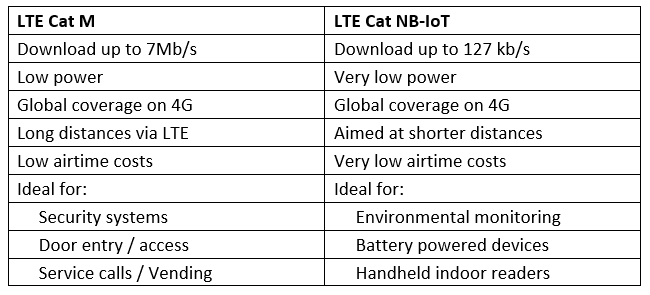Digital acceleration continues unabated with the global pandemic further hastening the focus and urgency for organisations in ensuring that they have total visibility of their assets. This quickening has been further supported by the role out of 5G which although in the early stages of commercialization promises higher bandwidth, enhanced reliability and lower latency. Collectively this is referred to as QoS (quality of service) and is indeed needed for the next generation of IoT devices driving the digital transformation. With 2G / GSM and 3G / UMTS networks now starting to be phased out, network technologies in the form of LTE Cat M and LTE Cat NB-IoT will increasingly support LPWAN in enabling global mass IoT connectivity.
Even though 5G has been available since July 2019 availability has been slow to come online when compared with the equivalent coverage offered by 2G/3G and LTE. The impact in speed of deployment resulting from the smaller cell sizes and larger overall infrastructure required for the new technologies when compared to that deployed for previous standards.
The spectrums within 5G can be broken down into three categories, namely;
- Sub-GHz.
- 1 – 6 GHz.
- High band mmWave.
The “sub” 1 GHz spectrum is primarily used for 3G and 4G / LTE Cat 4 with this option offering broad coverage, good building penetration and with data speeds up to 100 Mbps. This spectrum is the focus of many wireless companies where the highest data rate is not a primary concern. Overall, the QoS of 5G makes mass market IoT a reality connecting large numbers of narrow-band devices sending and receiving small data packets on an infrequent basis.
LTE Cat M and LTE Cat NB-IoT have co-existed with LTE/4G since 2017 both fulfilling all 5G requirements from the 3GPP and addressing different types of use cases. LTE Cat M is designed to support machine communications as a direct replacement for 2G / GSM and is more commonly referred to as Cat-M while NB-IoT is stand alone and essentially offers a lower bandwidth version of 2G / GSM such as CSD. Neither of these alternatives use significant bandwidth and both offer lower cost data plans with improved power efficiency and higher link-budgets with improved received sensitivity.
Despite the limited roll out of 5G the number of commercial adoptions using LTE Cat M and LTE Cat NB-IoT continues to grow with solutions that are functional today and ready for 5G adoption as this becomes more readily available. Assistance with adoption and transition to the newer technologies being available and supported by companies like Siretta, the Industrial IoT company.
As forerunners to 5G, LTE Cat M and LTE Cat NB-IoT devices will continue enabling the industrial IoT revolution and products are available from companies such as Siretta who offer a wide range of modem solutions such as the ZETA series of industrial products connecting equipment to the new LTE Cat M and LTE Cat NB-IoT networks whilst also providing connectivity to the existing 2G / GSM cellular networks. These products are suitable for a wide variety of applications and requirements and Siretta offers a ‘modem selector tool’ to support your needs.
LTE Cat M is one of the earlier systems specified in the 3GPP release 13 and extended in Release 14. Specifically, it is a low power wide area network designed for IoT and has the advantage over other low power networks such as Sigfox or Lora. This is because it is owned and run by the 3GPP and is running on a licensed band as opposed to the ISM un-licensed bands which work by having rules in place on who can send data at any specific time along with the size and speed of data. This means that for these un-licensed options, the more connections in an area the more the bandwidth has to be reduced to accommodate the number of users, meaning the more traffic present in the network, the lower the message numbers and the lower the available payload.
LTE Cat M operates in small cell sizes meaning less users per cell allowing for equal bandwidth usage. Modern LTE and 5G encompasses high speed and high bandwidth channels for Video streaming and Social media. Yet, most IoT solutions only require small data packages on an infrequent basis so speed is generally not an issue. With LTE Cat M you have downlink speeds up to a maximum of 4Mbits/s and uplink speeds up to 7Mbits when compared to the latest categories of LTE and 5G which now offer Gigabit plus data rates.
As airtime contracts are based on data usage IoT use of low bandwidth will bring with it overall lower networks costs. Other advantages are the availability of services through third parties such as cloud services through the likes of AWS, Azure and Google. Connections are bidirectional, always connected and support OTA (over the air) firmware and software updates.
LTE Cat NB-IoT is an important part of 3GPP release 17 and already has more than 100 million deployed devices. Specifically designed for very low power and very low data rates, up to a maximum of 127kb/s, it is ideal for short range low power devices as the lower data rates and high sensitivity reduce power consumption. It is aimed at massive IoT rollout capable of scaling to 1 million devices per kilometer which is more than 10x the coverage of 4G and a critical component in 5G (cellular IoT). This is resulting in LTE Cat NB-IoT gaining recognition as a 5G standard and a key element in mMTC (massive machine type communications) especially for battery powered indoor short range IoT devices i.e. for payment terminals. Again, due to the lower data rates cost of air time contracts will be reduced dramatically.
LTE Cat M and LTE Cat NB-IoT will continue to bridge the gap as we move towards an entirely LTE / 5G based network. Their lower costs will be a key element in driving mMTC with LTE Cat NB-IoT seen as a fundamental element in the role out of 5G. Most current 5G networks are in fact tweaked 4G networks meaning that when full 5G radio is installed all the current 3GPP standards will be transferred and supported on 5G. The current coverage for 5G is limited to high user areas but by adopting the LTE Cat M or LTE Cat NB-IoT standards, existing equipment can easily be migrated from legacy 2G / GSM and 3G / UMTS systems to 4G/LTE networks with confidence.
The choice of service between LTE Cat M and LTE Cat NB-IoT should be considered an either/or decision and is more predicated around the use case and requirements of the end application. LTE Cat M with its higher bandwidth and lower latency clearly offers a better fit in certain use cases and applications vs. LTE Cat NB-IoT offering low bandwidth data connections, lower power and lower cost. It is also important to flag that the geographic role outs also have an impact with LTE Cat NB-IoT being more European focused vs. LTE Cat M which is seeing much faster adoption in the US.
LTE Cat M vs. LTE Cat NB-IoT Selection Criteria

LTE Cat M vs. LTE Cat NB-IoT Optimal Performance

There is no doubt that 5G will offer spectacular growth in IoT devices and in just a few years the availability of these networks will offer control and monitoring of very small devices to very large, sophisticated, streaming live, real time video and realtime critical devices.
To prepare for the explosion of lower bandwidth devices we can already adopt the LTE Cat M and LTE Cat NB-IoT benefits and these will continue to be developed and become available. As the networks expand coverage then the new Gigabit systems will become more useable. IoT device deployments could grow by billions of units. IHS Markit is predicting that 5G IoT deployments could balloon to around 140 billion devices by 2030.
Siretta understand the challenges faced in making the right hardware decision and we have developed our ‘Modem Selector tool’ to help reduce your time to market. Our portfolio includes cellular modems & terminals, industrial routers, cellular network analysers, RF antennas including solutions for WLAN, LoRa and Sigfox. We offer RF cable assemblies and RF accessories. Frequencies are typically within the 75MHz – 5.8GHz range covering the HF, VHF, ISM, Cellular, GNSS frequencies.
We also offer bespoke customer solutions, and our design services are supported by an experienced team of dedicated development & application engineers as well as software specialists offering complete end to end solutions with a heavy emphasis on high level system design.

